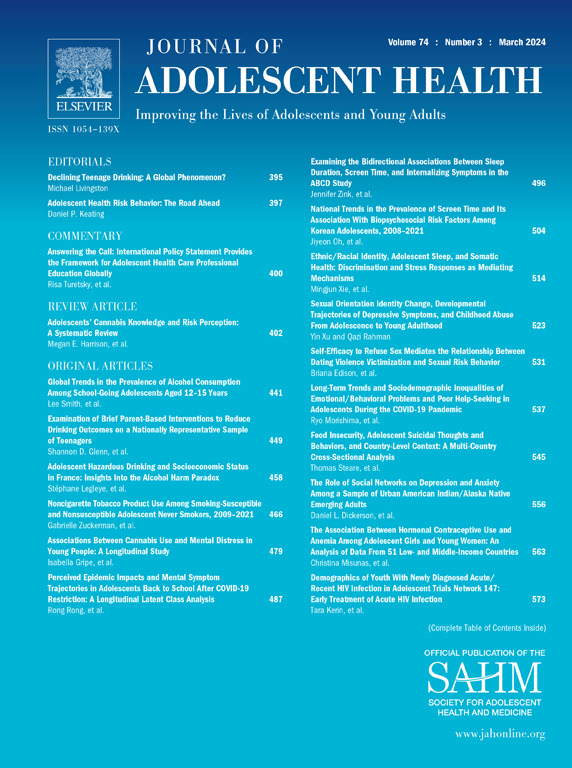在 COVID-19 大流行期间,综合医疗系统中青少年淋病和衣原体检测及感染趋势。
IF 4.5
2区 医学
Q1 PEDIATRICS
引用次数: 0
摘要
目的:COVID-19 大流行影响了性传播感染 (STI) 的检测和发病率,一些研究显示不同社会人口群体受到的影响并不均衡。我们旨在确定淋病和衣原体检测率和感染率是否受到大流行的影响,包括总体影响和根据社会人口因素和合并症定义的亚组影响:我们从 2016 年 1 月 1 日到 2022 年 12 月 31 日对北加州凯撒医疗集团 (KPNC) 的 15-29 岁青少年和年轻成年人进行了一项回顾性队列研究。我们根据社会人口因素确定了淋病/衣原体检测率,以及 COVID-19 大流行之前和期间的感染率。我们使用泊松回归法比较了大流行前和大流行期间淋病/衣原体检测和感染的发生率:结果:大流行期间的淋病/衣原体检测率比大流行前的基线低 19%。黑人患者的检测率是白人患者的 1.8 倍。与白人患者相比,黑人患者的淋病和衣原体感染率分别高出 5.5 倍和 3.6 倍。与居住在最贫困社区的患者相比,居住在更贫困社区的患者感染率也更高。在按 COVID-19 流行前和流行期间分层的多变量分析中,任何特定社会人口因素的检测或感染发生率比均无显著差异:讨论:大流行开始后,青少年的性传播感染检测率急剧下降,至今仍未恢复到之前的水平。大流行并没有加剧性传播疾病检测和感染方面原有的差异。本文章由计算机程序翻译,如有差异,请以英文原文为准。
Trends in Gonorrhea and Chlamydia Testing and Infections Across the COVID-19 Pandemic in Adolescents and Young Adults in an Integrated Health System
Purpose
The COVID-19 pandemic impacted testing and incidence of sexually transmitted infections (STIs), with some studies showing uneven effects across sociodemographic groups. We aim to determine whether rates of gonorrhea and chlamydia testing and infections were affected by the pandemic, overall and by subgroups, defined by sociodemographic factors and comorbidities.
Methods
We conducted a retrospective cohort study from January 1, 2016, through December 31, 2022, among adolescents and young adults ages 15–29 years within Kaiser Permanente Northern California (KPNC). We determined the rate of testing for gonorrhea/chlamydia, and the incident rates of infections before and during the COVID-19 pandemic by sociodemographic factors. We compared incidence rates of gonorrhea/chlamydia testing and infection before and during the pandemic using Poisson regression.
Results
Gonorrhea/chlamydia testing during the pandemic was 19% lower than prepandemic baseline. Testing among Black patients was 1.8-fold higher than White patients. Black patients had 5.5 and 3.6-fold higher rate of gonorrhea and chlamydia infections, respectively, compared with White patients. Patients living in more deprived neighborhoods also had higher rates of infection compared to those in the least deprived neighborhoods. In multivariable analyses stratified by the period before and during the COVID-19 pandemic, there were no significant differences in the incidence rate ratios of testing or infections for any specific sociodemographic factor.
Discussion
STI testing in adolescents and young adults dropped dramatically after the start of the pandemic and has not recovered to its prior levels. Preexisting disparities in STI testing and infections were not exacerbated by the pandemic.
求助全文
通过发布文献求助,成功后即可免费获取论文全文。
去求助
来源期刊

Journal of Adolescent Health
医学-公共卫生、环境卫生与职业卫生
CiteScore
10.40
自引率
3.90%
发文量
526
审稿时长
46 days
期刊介绍:
The Journal of Adolescent Health is a scientific publication dedicated to enhancing the health and well-being of adolescents and young adults. Our Journal covers a broad range of research topics, spanning from the basic biological and behavioral sciences to public health and policy. We welcome a variety of contributions, including original research papers, concise reports, literature reviews, clinical case reports, opinion pieces, and letters to the editor. We encourage professionals from diverse disciplines such as Anthropology, Education, Ethics, Global Health, Health Services Research, Law, Medicine, Mental and Behavioral Health, Nursing, Nutrition, Psychology, Public Health and Policy, Social Work, Sociology, and Youth Development to share their expertise and contribute to our mission of promoting adolescent health. Moreover, we value the voices of young individuals, family and community members, and healthcare professionals, and encourage them to submit poetry, personal narratives, images, and other creative works that provide unique insights into the experiences of adolescents and young adults. By combining scientific peer-reviewed research with creative expressions, our Journal aims to create a comprehensive understanding of the challenges and opportunities in adolescent and young adult health.
 求助内容:
求助内容: 应助结果提醒方式:
应助结果提醒方式:


